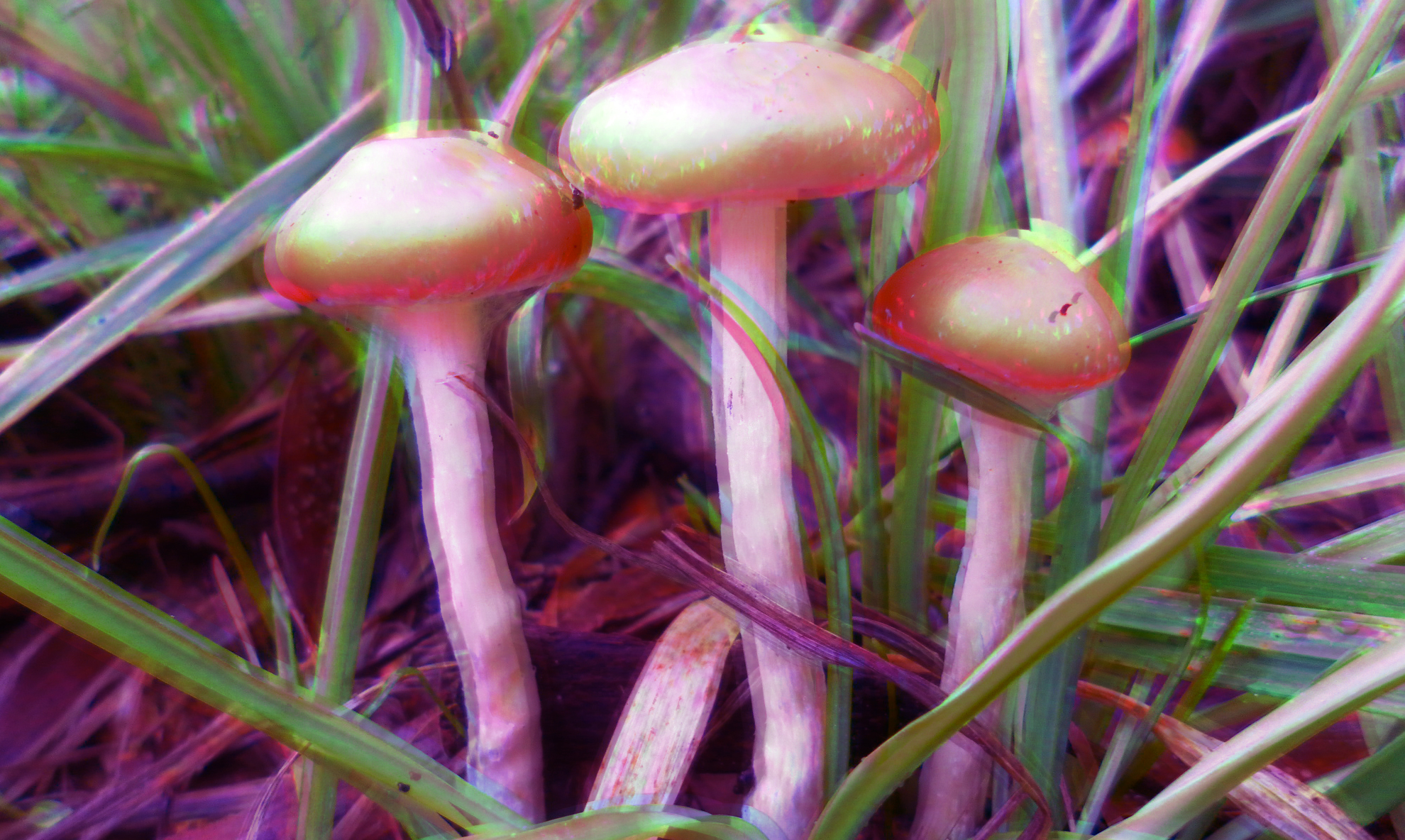
It's getting dark early, the days are getting colder, and it’s been raining. If all that rain has you thinking about foraging for magic mushrooms, the first thing we’d tell you is don’t go it alone – find someone who can help identify your shrooms.
This is not a situation where you want to fuck around and find out.
If you’re not sure what you’ve got, then we recommend you don’t eat it. Even experts find it hard to identify mushrooms, and the wrong kind can be deadly – or if not deadly, very toxic and uncomfortable (think severe abdominal pain, vomiting, diarrhea and convulsions). Don’t just take it from us – here’s what KnowYourStuffNZ and High Alert have to say.
The good thing is, learning about identification and where to seek expert help can mean you avoid a dodgy shroom situation. We talked to Joel Faulkner, an ecologist and harm reduction enthusiast, for some tips on staying safer when shroom hunting.
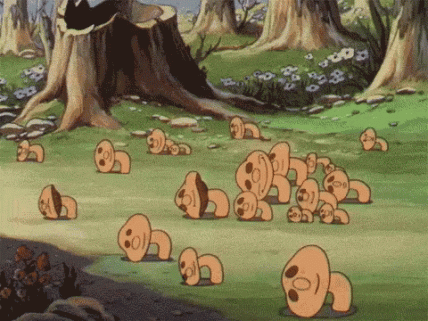
Kia ora Joel. So tell us - how do you know so much about shrooms?
I'm an ecologist who studies insects and plants. Through my studies I’ve learned about how to identify different plants, fungi and insects. I've also been volunteering with Know Your Stuff for about two years, helping people check their drugs, and I’m passionate about reducing harm for people who use drugs.
When people talk about shrooms in New Zealand, what species are they talking about? What are the colloquial names people might be using?
The broadest level of colloquial naming is gold tops and blue meanies, but those terms were largely brought in from overseas. The term ‘blue meanies’ comes from the way shrooms bruise blue if you crush them, but in New Zealand we actually have a pale blue species – Psilocybe weraroa.
The main two species you find here are Psilocybe subaeruginosa (colloquially called gold tops or subs, along with a wavy capped form sometimes called Psilocybe cyanescens) and Psilocybe weraroa (sometimes known as Weraroa novae-zealandiae, and colloquially called blue meanies).
Then there’s a few species that grow in pot plants, Psilocybe aucklandiae, Psilocybe tasmaniana and Psilocybe angulospora, along with a few other regional species/variants that are less common. These are also colloquially known as gold tops.
Bit confusing, right? There's still some debate in New Zealand about how to best classify different shrooms, but where possible, try to use the proper names of your shrooms to minimise confusion.
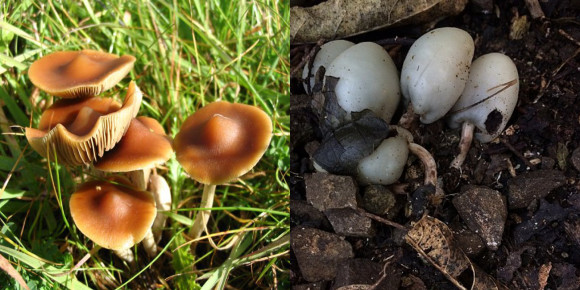
Psilocybe subauruginosa (left, showing open gills) and Psilocybe weraroa (right, showing closed caps).
Why is identifying your shrooms so important?
The same as any other harm reduction measure – it helps you understand what you're taking and potentially stops you from eating something that could kill you or make you sick.
I know how exciting it can feel to potentially find shrooms when you’re out hunting. But remember, never consume anything you're not 110 percent certain about! I hear ridiculous stories about people going around eating random mushrooms – this is not recommended.
Unfortunately, this lack of conversation is driven by the illegality of shrooms. They are a Class A drug, so people are scared to ask, and then they just go 'fuck it’ and eat whatever's in front of them.
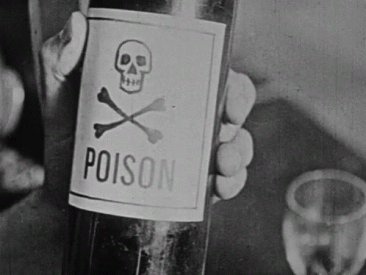
What’s the worst that could happen if you don't identify your shrooms?
There are a few different worst-case scenarios. Of course, the absolute worst-case is death – and that’s a real risk. Stomach pain, diarrhea, vomiting, liver or kidney issues – these are all possibilities too. Know Your Stuff has some good info on the toxic lookalikes you might encounter. You can help protect yourself by applying basic ID skills. You want to be cautious, but channel that into learning about identification.
How can people learn more about identifying shrooms?
Get familiar with mushrooms in general – knowing the parts of a mushroom can help you talk to others to identify what you've found. Practice identifying other species of mushrooms, know what's growing around you, and what it’s growing on.
There's a big difference between being confident to name a mushroom, and being confident to eat it. As people develop that knowledge, they can extend it to specifically identifying magic mushrooms.
For anything people might consume, we really want to be able to point out three key physical features that identify the species. My ecology lecturers always wanted to know how you'd identified a plant or insect, even if they already knew you had the right answer of what it was.
Any time you're looking for a particular mushroom species, find out where it normally grows - both the environment and the substrate (the thing it's growing out of). Some examples of substrate are wood chip, dead trees or grass. This info is easily found for any mushroom species in field guides or websites.
At the right time of year, find an area with the right environmental features and look for the right substrate. Other important factors would be:
- not too much sunlight
- moisture
- protected, damp corners
Once you’ve found the right place, a good way to get your skills up is to look for species that grow alongside the species you're looking for.
Just going on a general mushroom walk with someone who knows what they're doing is helpful - you don't need to always find something, but those general ID skills will help you in the long run.
Who can help with identifying shrooms?
It's harder going out on your own using the internet, so try and connect with others in your area who go mushroom hunting and learn from them. A lot of foraging relies on word of mouth and learning from other people.
There are many online forums you can look to for help with ID, like The Shroomery. It’s worth downloading the iNaturalist app, too.
There are general mushroom foraging Facebook groups – people are super friendly and helpful and will direct you to a magic mushroom group if they think that’s what you have.
What do others need in order to help you identify your shrooms?
If you're going to rely on other people's time to ID your shrooms, and you want them to take you seriously, you will need to supply proper, high-quality photos. Get photos of the mushroom in its habitat, and close-up photos of its stem, gills, top, then cut in half. All of these photos are very useful but remember to always proceed with caution when relying on online identification.
Spore prints can also help with identification of mushrooms with open gills (like gold tops). Cut the stem off flush with the cap of the mushroom and put the cap gills-down on white paper – usually with another piece of paper on top. Put a medium-sized novel on top, enough to weigh it down but not squash it, and leave it for about six hours. Don't move it or you'll mess up the spore print.
You’re looking for a chocolate-brown or even purple-ish spore print. You can take a photo of the spore print to include with your photos if you're getting someone to help you ID the shroom online. Taking a spore print doesn't affect the shroom's consumability.
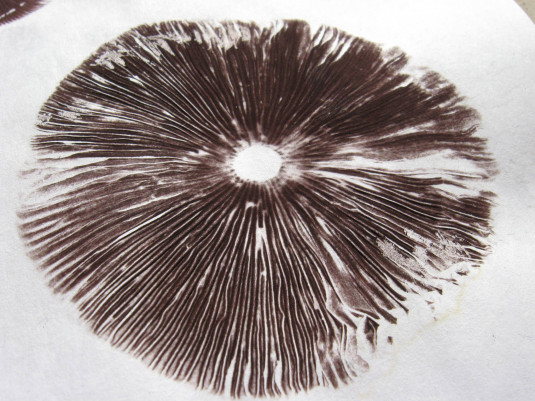
Psilocybe subauruginosa spore print, by karode13 on Shroomery.org
Is it true that councils spray for mushrooms?
There's a common misconception that the local councils spray fungicide for magic mushrooms. That’s unlikely to be true, but they do spray bark gardens with herbicides to control weeds, and the odd fungicide or pesticide on things like rose bushes. Generally, any spray that is harmful for people will have a red, green or yellow dye. That dye stays on the substrate for as long as the chemical is active – so avoid those gardens if you spot dye.
Thanks a lot Joel!
Related stories
Recent stories
SMART Recovery: Support groups without the need for abstinence or a higher power
We explore what it is and how it has positively affected people's lives.
Kamini: What you need to know
EDs and doctors have seen more people seeking help for opioid overdose, withdrawal, and addiction after using kamini. Here's what you need to know about the opioid-containing remedy.
Pseudoephedrine: what you need to know
Pseudoephedrine is back on the shelves. Here's what you need to know about this cold & flu medication.